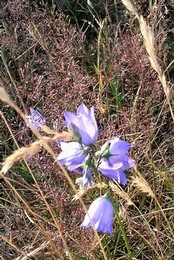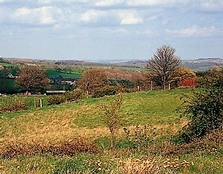

Biodiversity
Action
Plan

Acid grassland. The tussocky vegetation of Acid Grassland pastures supports birds such as Curlew, Lapwing, Skylark and Meadow Pipit together with mammals such as Brown Hare.
Many invertebrates that occur in Acid Grassland are not found elsewhere and this grassland is important for bumblebees and solitary bees.
Semi-natural Acid Grassland is sustained primarily by grazing.
Notable areas of unimproved or semi-improved Acid Grassland in Barnsley are found on the slopes of Hartcliffe Hill and the hills near Ingbirchworth and Thurlstone, on Wharncliffe Chase, Brockholes and Blackmoor common, and in pastures near Hood Green.
Many small sites such as field corners and banking occur throughout the borough as remnants of this habitat. It can be found on former colliery sites that have not been reclaimed and older bell-pits like those at Tankersley golf course.
Acid Grassland is found on poor soils on sandstone edges in Barnsley, on slopes where the soil has been leached of nutrients, and where there has been mining, quarrying or other such activities*
Priority habitat details
Unimproved and semi-improved Acid Grassland is a UK BAP broad habitat category.
Lowland Acid Grassland is a national priority habitat, UKHab category g1a
Natural England identifies grassland with at least one frequent and three occasional examples from a list of 25 wildflowers as Lowland Acid Grassland priority habitat.
Acid Grassland that meets the criteria in Barnsley, as well as nationally, is quite scarce and under threat.
Acid Grassland is a local priority habitat because of this scarcity, the plants and wildlife it supports and although much has been lost in Barnsley, the opportunities for its conservation.
Unimproved and semi-improved Acid Grassland are identified in Phase 1 habitat surveys.
There are four main National Vegetation Classification (NVC) categories in Barnsley.
U1 Bent Fescue-Sorrel pasture
U2 Wavy Hair Grass pasture
U4 Bent-Fescue pasture
U5 Mat Grass pasture
Acid Grassland is often part of a mosaic with Heathland: where the cover of dwarf shrub is less than 25%, the habitat is considered to be Acid Grassland.
*Acid Grassland may form part of the Open Mosaic on Previously Developed Land priority habitat on former colliery sites,
Grasses which tolerate the poor soils include Wavy-Hair Grass, Common Bent, Sweet Vernal Grass, Sheeps Fescue and Mat Grass.
Acid Grassland has fewer broadleaved plants than Neutral Grassland; the Acid Grassland on rough moorland grazing has fewer still.
However Acid Grassland below the moorland where not improved for agriculture, can have a wider range of herbaceous plants. These include:


Betony, Bitter-vetch, Devils-bit Scabious, Harebell, Heath
Bedstraw, Lady’s Bedstraw, Sheep’s Sorrel and Tormentil.
For more information on Acid Grassland follow these links:

Acid Grassland